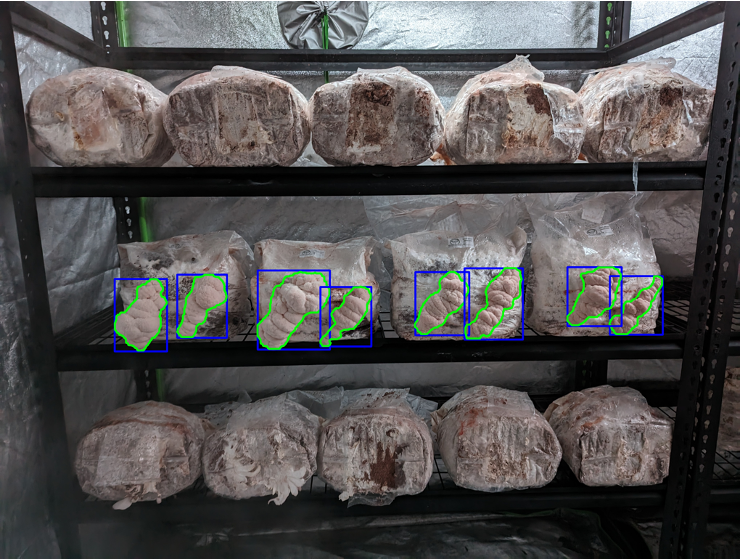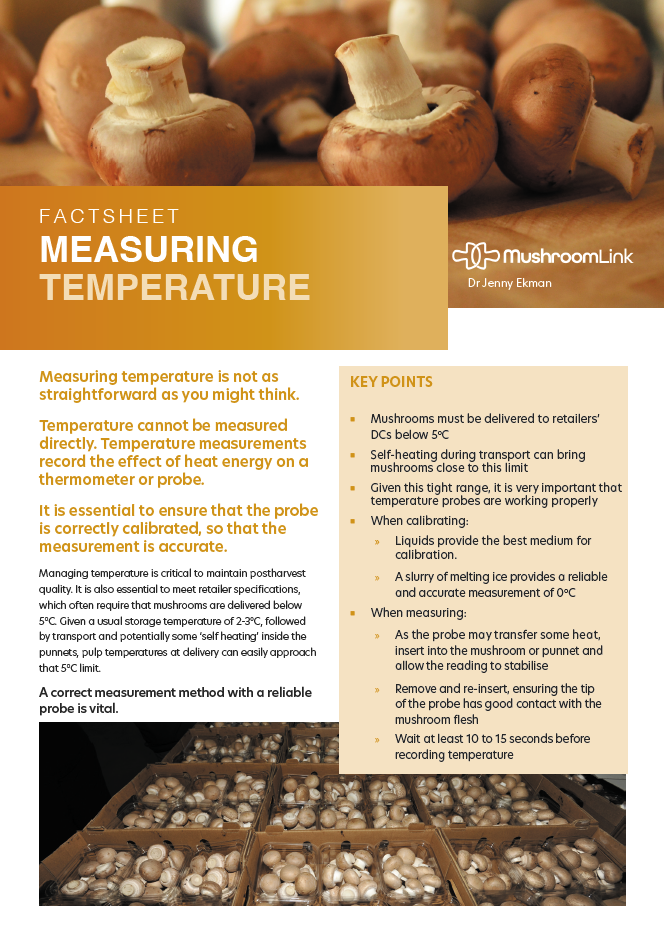MushroomLink Bulletin March 2024 - Magazine Autumn Issue
In this edition:
MushroomLink magazine: Autumn issue out now
Feature article: Cold mushrooms are quality mushrooms
Marketing: What’s planned in the coming months?
Podcasts: Revisit the MushroomLink podcast back catalogue
Fact sheet: Actions points to control Sciarid and Phorid flies
AMGA conference scholarship
Nuffield scholarships now open
MushroomLink Magazine Issue 08
We hope you enjoy this issue, with its usual mix of R&D news, the latest in technology from around the world, and pest and disease updates.
You can subscribe to an e-copy of MushroomLink magazine here or view previous issues here
Click here to download the magazine
Articles:
Levy-funded project updates:
Educating on the benefits of mushrooms in health care settings
Current Hort Innovation Mushroom Fund projects
Marketing:
Mushroom experiential product sampling goes to the beach
Main current contracted marketing project actuals at 2022/23 and 2023/24
Pests and diseases:
Growing & technology:
In each issue:
Grow Room Sanitation - Start clean, crack down on disease
With declining access to traditional disease control chemicals and mounting consumer resistance to chemical residues in agriproducts, effective on-farm disease management will become increasingly reliant on preventative hygiene. effective grow room sanitation is a prescribed multi- step process, but the efficacy of the protocol can be influenced by the physical characteristics of the farm and ‘events’ that may occur within the facility.
During the recently completed project Development of a pilot Mushroom farm Disease Monitoring Scheme (MU12007), extensive sampling on bubble-affected farms highlighted some features to be considered to ensure your sanitation protocol is as effective as it can be.
This article was originally produced for the Australia Mushrooms Journal
Containment strategies for dry bubble
Part of this work was carried out under the auspices of HIA Project MU12007
Put your foot down! Ensure your foot dips are safe to use and fit-for-purpose
One of the key aims of on-farm biosecurity and Integrated pest Management (IpM) programs is to prevent exposure of the crop to mushroom pathogens.
This is achieved through the implementation of three basic concepts: exclusion, containment and elimination.
Mushroom growers are at an advantage over most other horticultural crops as they are able to control pest movement in and out of growing rooms and one of the simplest tools used to exploit this advantage is the foot dip.
This article was originally produced for the Australian Mushrooms Journal
Action points to control sciarid and phorid flies
Sciarid and phorid flies can breed in bushland, ‘waste’ or ‘spent’ compost in the farm environment and, most efficiently of all, in growing rooms. The odour associated with the phase 3 compost arriving on a farm either in bulk or blocks acts like a strong magnet to attract flies to the new crop.
The fact that a female sciarid can produce around 100 offspring and a female phorid can produce around 50 offspring means that new crops need to be vigorously protected from invasion by adults and a holistic and integrated approach to fly control is required.
This article was originally produced for the Australian Mushrooms Journal
MushroomLink Bulletin February 2024 - FY25 Marketing strategy webinar recording
In this edition:
Launch of the 2022/23 Australian Horticulture Statistics Handbook
Webinar: Catch up on last week's webinar with Monique Emmi
Feature article: It’s not easy being green. New advances in Trichoderma research
Audio article: Phorid ecology and management
Dr Agaricus: What is foaming disease?
MushroomLink 2024 publication schedule
MushroomLink Bulletin January 2024 - Marketing webinar
In this edition:
Marketing webinar: REGISTRATIONS OPEN
New developments from the mushroom SIAP
Feature article: Growing mushrooms with AI assistance
Listen: NEW: Audio article - Chemical storage
NEW resource: Taking your mushrooms' temperature
Research from around the world: New biofilm that improves postharvest quality
ISMS conference with side symposium
Fact sheet: Measuring temperature
Measuring temperature is not so straightforward. By measuring temperature, you are actually measuring the effect of the energy within the mushrooms on another item – usually a metal temperature probe.
Managing temperature is not only essential to maintain postharvest quality, but also to meet retailer specifications. Mushrooms must be delivered below 5 Celsius. Given a usual storage temperature of 2-3 Celsius, followed by transport and potentially some ‘self-heating’ inside the punnets, they can be perilously close to this limit when delivered.
Measuring temperature sounds easy, but a number of things need to be considered, including calibrating your thermometer.
This fact sheet, prepared by Dr Jenny Ekman, describes the best ways to measure temperature in punnets of whole mushrooms and sliced mushrooms. Dr Ekman also provides insight into best practice calibration of temperature probes.
MushroomLink bulletin December 2023 - New Magazine!
In this edition:
New magazine: Our summer issue is here
Feature article: Best practice in mushroom supply chains
Marketing update: Webinars past and future
Podcast: Just dropped - Introducing the MUSHRoom
MushroomLink 2024 publication schedule
ISMS conference with side symposium
MushroomLink Magazine Issue 07
We hope you enjoy this issue, with its usual mix of R&D news, the latest in technology from around the world, and pest and disease updates.
You can subscribe to an e-copy of MushroomLink magazine here or view previous issues here
Click here to download the magazine
Articles:
Introducing the MUSHRoom with Dr Emma Beckett
In this episode, MushroomLink’s Dr Jenny Ekman chats with Dr Emma Beckett about the Hort Innovation project MU22006, Online resource for mushroom health & nutrition science for healthcare professionals.
Emma and the team at FoodIQ Global (Formerly Nutrition Research Australia – NRAUS) are creating the ‘go to place’ for credible and authoritative information on the health benefits of mushrooms. By showcasing the unique health benefits of mushrooms to health professionals, the project hopes to increase the number of practitioners ‘prescribing’ Agaricus mushrooms as a source of nutrition.
Emma discusses the value of a reliable resource created for health professionals by health professionals that goes beyond marketing grabs.
The website or ‘MUSHRoom’ will be a living resource that will be updated regularly as new information becomes available. By consolidating all credible information in once place, knowledge gaps will become clear and can be prioritised for further research.
To find out more visit the Hort Innovation project page here: https://www.horticulture.com.au/growers/help-your-business-grow/research-reports-publications-fact-sheets-and-more/mu22006/
Visit the FoodIQ Global website here: https://www.foodiq.global/
Cost of living, consumer behaviour and the implications for the mushroom category
Hort Innovation's Consumer Insights Manager Wendy Hubbard speaks on the cost of living, mushroom category performance, consumer behaviour and the implications for the mushroom industry.
Wendy is a seasoned insights professional with over two decades of experience in the consumer insights industry. Her expertise lies in identifying opportunities and challenges using multiple data sets and transforming these insights into compelling narratives that drive business growth.
She is currently the Insights Manager at Hort Innovation, where she manages consumer insights initiatives for the Australian horticulture industry.
Investigating non-synthetic ‘biorationals’ for pest and disease control
Disclaimer: This webinar contains mention of some products which are not registered with the APVMA, have not all been tested for use in mushrooms and therefore may not be suitable for mushroom growing. The information presented is for educational purposes only.
Dr Aimee McKinnon (Agriculture Victoria) is a research scientist leading the Hort Innovation funded project MU22000: Non-synthetic alternatives to complement pest and disease management practices in mushrooms.
The objective of the research is to review and evaluate available and potential biorational agents and formulations for their potential to control key pests and diseases of commercial mushrooms (Agaricus bisporus).
In this webinar, Aimee first outlined what biorational agents are, discussed what options are available in Australia, and presented how the experimental research is being conducted to assess novel biorationals for efficacy and compatibility with mushroom growing.
Aimee has expertise working with insect pathogens and with beneficial soil microorganisms for plant health. She has experience in developing molecular diagnostic methods and in biological control of insect pests for IPM.
This webinar was made possible through the Hort Innovation project MU20003: Mushroom industry communications program. It has been funded through the Mushroom research and development levy and contributions from the Australian Government.
Other Resources
MushroomLink Bulletin November 2023
In this edition:
Marketing webinar: Registrations open for the first MushroomLink marketing webinar
Marketing campaign: Miguel Maestre on the radio waves
Feature article: Bringing mushrooms to centre stage in the Australian Dietary Guidelines
Watch and listen: What makes mushrooms so special? Revisit our podcast and webinar with nutritionist and scientist Dr Flavia Fayet-Moore and Dr Damien Belobrajdic
Factsheet: Mushroom nutrition and health messages
Case study: Monaghan Mushrooms
Research from around the world: Mushroom mathematics
Miguel Maestre radio spots
Miguel Maestre - aka the crazy bull - is enthusiastically promoting mushrooms on radio. The marketing team at Hort Innovation recently recorded the segments, which will be broadcast across Australia.
Listen to the six segments below.
Marketing activity aplenty
Off the back of a successful marketing campaign from July to September, the Hort Innovation marketing team is now overseeing the roll-out of activities for the remainder of this calendar year.
The FY24 quarter one campaign – involving radio, outdoor advertising panels, social media, shopper communications and a sampling program – aimed to inspire people to consume more mushrooms daily, by adding the Mighty Mushie to everyday meals.
Results from that campaign included:
· Metro and regional outdoor advertising reaching 3,707,367 adult grocery buyers
· Radio advertising reaching 3,581,474 adult grocery buyers
· Social media advertising reaching 8,419,254 adult grocery buyers
· Interim results for shopper communications (August only) showing the Woolworths campaign brought 24,000 ‘new to brand’ customers, generating $72,500 in sales during the campaign period.
The FY24 quarter two (October-December) integrated campaign is now well underway, involving radio, outdoor advertising, online shopper communications, social media and public relations activities.
Central to the current campaign is the creative idea of ‘Reinvent the Meal’ which brings to life the brand truth that ‘mighty Mushrooms can add a whole lot more flavour to ordinary meals’.
New recipes and visual assets are being unveiled throughout the campaign period to showcase delicious everyday meals and to inspire consumers to cook with mushrooms.
Celebrity chef Miguel Maestre is also taking centre stage during the campaign, having already headlined the Mushroom Festival in Melbourne, crossing live from Costa Mushrooms in Victoria and cooking a delicious recipe for the Studio 10 television program, and generally promoting mushroom month in October.
The summer edition of MushroomLink magazine will contain more information about all the mushroom marketing activities and achievements.
MushroomLink Bulletin October 2023
In this edition:
Magazine: Spring issue out now
Feature article: Changing how we look at mushrooms
Doctor Agaricus: Ventilation within the compost matrix
MLMRU update
Research from around the world
Upcoming webinar – registrations open
Food safety free testing wrapping up
Marketing update
Mushroom fund annual report
MushroomLink Magazine Issue 06
We hope you enjoy this issue, with its usual mix of R&D news, the latest in technology from around the world, and pest and disease updates.
You can subscribe to an e-copy of MushroomLink magazine here or view previous issues here
Click here to download the magazine
Articles:
Bacteria vs Fungus; Using Bacillus to control Wet Bubble Disease
Wet bubble is a widely distributed disease caused by the fungal parasite Hypomyces perniciosus (formerly Mycogone perniciosus). Recently it has been found that related pathogens, including M. rosea and M. xinjiangensis, can also cause symptoms.
Wet bubble is a widely distributed disease caused by the fungal parasite Hypomyces perniciosus (formerly Mycogone perniciosus). Recently it has been found that related pathogens, including M. rosea and M. xinjiangensis, can also cause symptoms.

































